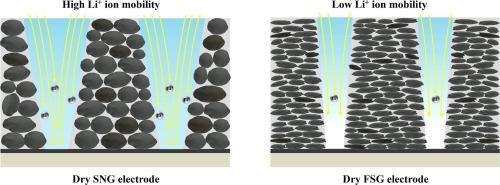Relationship between particle shape and fast-charging capability of a dry-processed graphite electrode in lithium-ion batteries
Abstract
Improving lithium-ion transport in electrodes by controlling electrode microstructure is a promising option for enhancing the fast-charging capability of graphite anodes in lithium-ion batteries. Dry processing of electrodes based on a polytetrafluoroethylene binder has attracted considerable attention as an alternative to solvent-based wet processing. The morphology of graphite particles has a significant impact on electrode microstructure, but few reports have been published on dry-processed graphite anodes. In this work, we found that the morphology of graphite particles is a key factor to determine the fast-charging capability of the dry-processed graphite electrode as well as the microstructure of the dry-processed graphite electrode. X-ray microscopy combined with mercury porosimetry and symmetrical cell electrochemical impedance spectroscopy reveal that the difference in porosity between the top and bottom layers of a dry electrode with spherical graphite particles is greater than that of flake-shaped graphite particles, resulting in enhanced lithium-ion transport in the electrode and improved fast-charging capability at a high charging rate of 5C (17.5 mA cm−2). These findings supply insights into the effective design of dry-processed graphite anodes with an emphasis on fast-charging capability as well as the development of graphite anode materials for dry-processing based lithium-ion batteries.


 求助内容:
求助内容: 应助结果提醒方式:
应助结果提醒方式:


